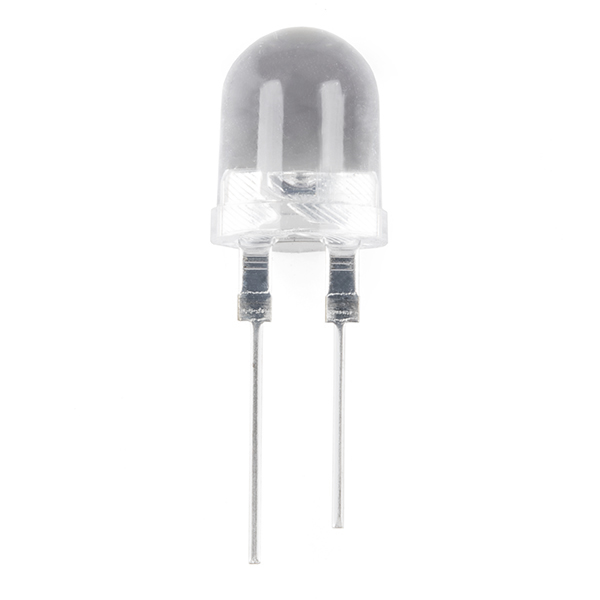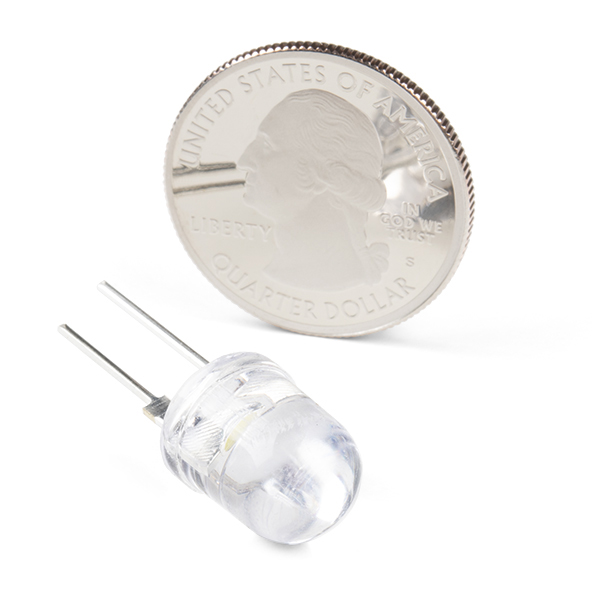Huge 10mm through-hole LEDs. Mood-light an entire wall!
- 2.1-2.3VDC Forward Voltage
- 80mA Forward Current
- 30 degree viewing angle
- 10,000-12,000 MCD output
Super Bright LED - Yellow 10mm Product Help and Resources
Core Skill: Electrical Prototyping
If it requires power, you need to know how much, what all the pins do, and how to hook it up. You may need to reference datasheets, schematics, and know the ins and outs of electronics.
Skill Level: Rookie - You may be required to know a bit more about the component, such as orientation, or how to hook it up, in addition to power requirements. You will need to understand polarized components.
See all skill levels
Comments
Looking for answers to technical questions?
We welcome your comments and suggestions below. However, if you are looking for solutions to technical questions please see our Technical Assistance page.
Customer Reviews
No reviews yet.




I am running 3 of these (along with some slow cycling RGB led's and 2 small whites) inside a well ventilated nightlight for my daughter. I hooked them up each with a 1/2w 47 ohm resistor driven by a 5v 1A wall wart, My concern is the resistors are running uncomfortably hot to the touch, like around 160F. According to my math this should be running these at about 65mA and only about 25% of the resistors max current. Should I be concerned? When running these with two 100 ohm 1/4w resistors in parallel I had no noticeable heat on the limiting resistors. Shouldn't this be equivalent?
There's quite a few unknowns here - just how many LEDs, resistors, configuration (from description it sounds like they're all in parallel*) and physical layout+housing all affect things like the heat dissipated.
But just to answer your questions...
Yes, you should be concerned if the resistors are getting hot and it's just meant to be a nightlight. Nightlights should never run hot :)
Yes, two equivalent resistors in parallel should as a set have half the resistance and double the max power dissipation. At 50 Ohm (from 2x100 Ohm in parallel) you do get a bit less current and thus a bit less power dissipation required, but not significant.
I guess the missing question is "Why doesn't this seem to be the case?". I can think of a few reasons when measuring, but nothing on the order of the difference between 'uncomfortably hot' and 'no noticeable heat'.
You may wish to double-check the resistors.. maybe they're not the value you think they are (is the 47 Ohm resistor a 4.7 Ohm resistor?), or they're not the wattage rating you think they are. Or maybe I, and two people I asked because as far as I know this shouldn't be happening, am missing something.
As a more general note, you could also try to wire more of the LEDs in series. This may not be an option for the auto-cycling RGB LEDs (you'll have to try and see if they're okay with being in series - if they're not, failure modes are usually being stuck at the initial color, or an erratic color program) but for e.g. these LEDs, even at their upper voltage drop range of 2.3V, you can have 2 in series, and at their lower voltage drop range they'd still drop 4.2V, leaving only 0.8V to get rid of across a resistor and thus less heat dissipated. Of course there are down sides - if 1 LED fails, the other does nothing / dies pretty quickly.
Only the 3 superbright resistors are running hot, using some 47 ohm 5% 1/2W resistors from the shack. The cycling ones are hooked up in series in pairs with a 100 ohm 1/4w resistor they aren't hot, neither are the white leds, just these 80mA ones. I think I will either try putting the superbrights in series or maybe just use a voltage regulator to bring the voltage down. On a side note, they have run for a while now and show no negative effects of having those 1/2w run hot. They are raised off of the PCB some and gapped from the rest of the wiring.
The picture of the LED is correct; it's more of a gold color than a pure yellow (it's almost orange). Actually it's a very pleasant color.